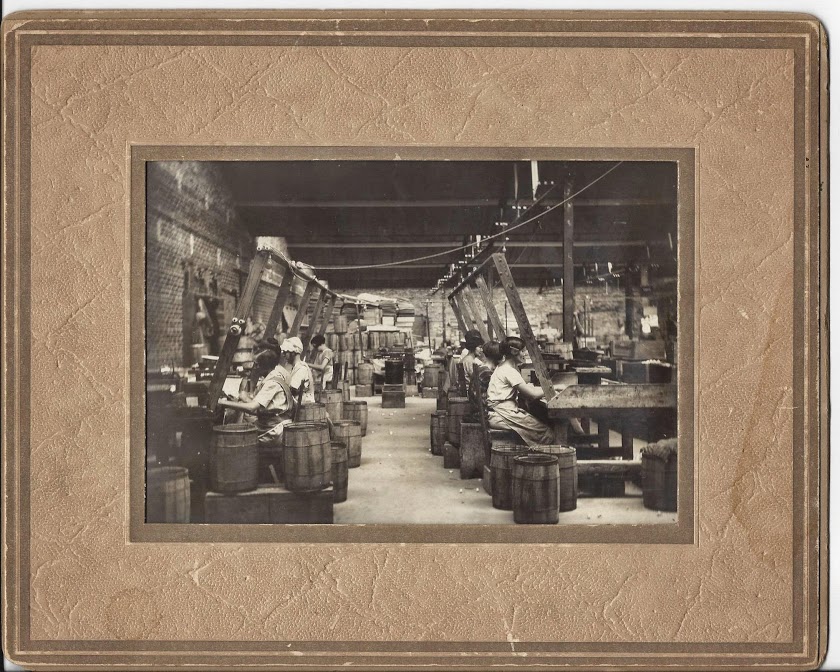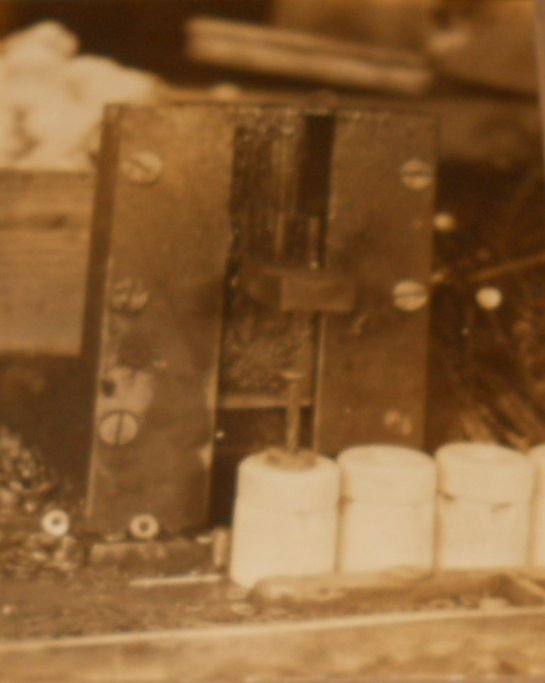
The July Artifact of the Month features two photographs of the Illinois Electric Porcelain Company of Macomb. Ron Scott, a life-long resident of Macomb donated the photographs to the museum in 2011. One image shows the interior of the Illinois Electric Porcelain Company with two rows of women sitting at workstations back-to-back, surrounded by wooden barrels. The other image shows a close-up of a machine containing porcelain insulators that are possibly about to have holes drilled into them. Each photo is dated on the back January 1927. They are mounted on board that measures 10 x 8 inches and the print size is 6.5 x 4.5 inches.
C.W. Kettron founded the Illinois Electric Porcelain Company (IEPC) in 1910. The company produced porcelain insulators for telephone and electrical companies. Porcelain insulators are used to support and separate electrical lines to utility poles and transmission towers without allowing current through them. The company was located in a large building that still stands at the corner of Pearl and Pierce Streets. Its address was 510-590 North Pearl Street and in the late 1920s, the company employed more than 200 people. The building now houses the Macomb Small Business Development Center and the Tri-County Regional Collection Facility.
The photographs belonged to Ron Scott’s parents, who were both long-time residents of Macomb. His mother, Oleta Scott was born August 2, 1918, in Colchester to Walter and Mary Sadler Powell. His father, Edwin D. Scott was born April 10, 1917, in Macomb to William and Annie Scott. A week after she turned 18 years old, Oleta married Edwin on August 9, 1936, in Macomb. Oleta and Edwin purchased a house on Ash Street, near the IEPC in 1943, and lived the rest of their lives there. Oleta passed in 2007 and Edwin passed in 1988. Ron Scott was born and raised in Macomb and still lives in the family home on Ash Street.
After his parents died and he was clearing out some family items, Ron Scott discovered both photographs tucked inside a photograph album. Scott assumes his parents saved the photographs because they had some family connection but he does not recall his parents ever speaking about the photographs. It is unclear if the photos show any of his family members.
Neither of Scott’s parents worked at the IEPC, his father worked for many years at the Hemp Factory, later called the King-Seely company, at the end of Hemp Road. Oleta Scott worked at Hemp during WWII helping to make bomb fins. Even though neither Oleta nor Edwin Scott ever worked there, the Illinois Electric Porcelain Company was still important to them. The Scott’s neighborhood was bordered by factories. On one side was the Hemp factory, on the other side was the Illinois Electric Porcelain factory. Factory work played a large part in many lives in Macomb before WWII and after WWII. In the northeast section of town where Ash Street was located, everyone worked at either the Hemp Factory or the Illinois Electric Porcelain factory.
Ron Scott has many memories of the Illinois Electric Porcelain Company. He remembers walking by it every day as a child. One of his most vivid memories is the smell of the factory. He recalls, “…walking by it you could smell the porcelain factory, to me it smelt like burnt electric wiring…” – possibly this was the smell of the porcelain as it baked in the kilns. Scott also recalled the other pervasive smell that hung over the area: the smell of paint that came from the Hemp factory. Everyday Ron Scott remembers his father coming home from the factory smelling strongly of paint.
Scott has many vivid memories of the two factories in his neighborhood including their sights, smells and sounds. Scott remembers walking by the porcelain insulator factory and hearing the sounds coming from within. He describes the whirring of the fans to cool the heat coming off the kilns and the clanks of the pieces of porcelain smacking against each other as they were moved across the factory floor.
Scott recalls that as a child, that if anybody in the neighborhood needed fill, to fill in a hole or any other reason, factory was willing to provide truckloads of broken porcelain insulators. Scott knows that buried in his own backyard are broken porcelain insulators. He remembers as a child his father dug up a big hedge in the backyard and used broken insulators to fill in the hole. Even today Scott says, sometimes when he digs in his backyard he will come across broken porcelain insulators.
A distinctive part of the Illinois Electric Porcelain Company building is its roof. Part of the factory building has a sawtooth roof that is still visible today. The first documented example of a sawtooth roof design is from 1851 in England and this type of roof became widespread during the Industrial Revolution, used in mills and other large manufacturing plants. This type of roof gets its name because the profile of the roof is similar in shape to the teeth of a saw. The roof is a series of ridges with dual pitches either side. The building is generally angled so the glass panels face to the north, which shields the workers and machinery from direct sunlight. The sawtooth design was developed to help provide uniform, natural lighting in large interior spaces in the days before electric lighting was commonplace. The design aimed to harness daylight and getting as much natural light into the interior of a large building which cuts down on the use of electric light. This sort of roof was especially efficient admitting natural light into a large building or factory, like the Illinois Electric Porcelain Company, which took up almost an entire city block. Without these overhead windows, the interior factory floor would have been very far away from the exterior windows. Once efficient artificial lighting became more widespread, sawtooth roof buildings became less prevalent. Lately there has been a renewed interest in this type of roof design due to its energy-efficient, eco-friendly qualities.
The Illinois Electric Porcelain Company photos were on display July 1 though 31, 2014.
Article by Heather Munro

